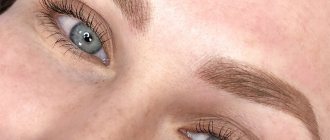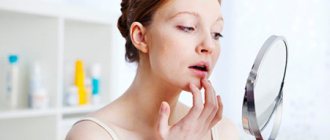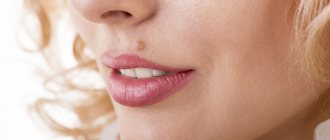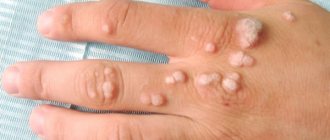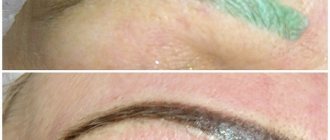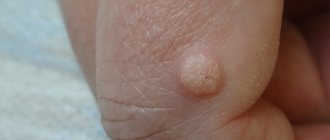Issues discussed in the material:
- The need for proper eyebrow care after permanent tattooing
- Pharmacy products for first eyebrow care after tattooing
- Reminder for eyebrow care during tattoo healing
- Detailed algorithm for eyebrow care after tattooing in the first seven days
- Eyebrow correction as an important stage of care after tattooing
Proper eyebrow care after tattooing is just as important as choosing a professional artist. An experienced eyebrow artist can not only highlight and emphasize the beauty of eyebrows, but even change the shape of the face with the help of competent correction. After the procedure in the beauty salon, the master must tell you what care should be like after tattooing.
If these rules are not followed, all the work may go down the drain - the eyebrows will lose color and shape ahead of time. If you are planning to tattoo your eyebrows, but don’t know why it’s dangerous to rip off the scabs and why you need Vaseline, read our article right now.
Recovery stages
The entire healing period can be divided into several stages:
- For the first 3 days, the eyebrows have a reddish tint, and a small amount of ichor is released.
- Over the next week, crusts form and fall off over time.
- After 10 days, the crusts disappear, the skin begins to peel off, increasing the brightness of pigmentation. After 14 days, the wounds heal, the skin is completely restored with new pigmentation.
- After a month, the skin is completely restored, the eyebrows acquire a natural shade and desired shape.
Everyone has their own healing time. It depends on the characteristics of the body and the method of tattooing. For example, when using the spraying method, fewer areas of the dermis are affected, so skin restoration occurs faster.
What influences the process of epidermal restoration?
Optimal and rapid fixation of the pigment is ensured by the hypoallergenic and sterile properties of the dye, that is, the less allergenic they are, the more favorable the process of pigment fixation (healing). This depends on the pH of the paint, on the purity of the component itself and on the non-use of components that have toxic properties. The quality of the needles used, the alloy of the steel, and the absence, for example, of nickel in the alloy (which causes long-term inflammation and healing of the skin) are important. Manufacturing and sharpening of needles, combination of composite materials in the production of cartridges and their guarantee of sterility.
As a result of all that has been said, we can conclude that permanent eyebrow makeup depends to a large extent not only on care, but also on the professional and competent approach of a specialist.
With this approach, healing proceeds calmly and unnoticed by the person, that is, it does not cause additional difficulties or inconveniences. It is enough to follow the recommendations of your specialist. As a rule, it is enough to moisturize the epidermis of the eyebrows with the product suggested to you and do not exfoliate the crust yourself (do not steam or peel off), but wait for natural exfoliation during the first week. And within a month, wait for the skin to completely recover and achieve the desired result.
Rules of care
The cosmetologist who performed the procedure should tell you in detail how to properly care for your eyebrows after tattooing. In the standard version, this looks like several mandatory skin care rules:
- After washing, do not use a rough towel. Remove moisture from the face using a soft cloth using small blotting movements.
- You should not peel off the crust that has formed; it must fall off on its own, otherwise the pigment will be absorbed unevenly.
- Try to avoid getting water into the tattoo area. Along with the liquid, an infection can be introduced, so you should wash your hair in advance.
- Do not take a hot bath or shower, and also refrain from going to the bathhouse or sauna until the skin has completely healed. When the skin is steamed, swelling and redness may increase.
- Do not use cosmetics, or wash your face with soap, foams, or gels containing alcohol.
- Avoid exposure to direct sunlight. In summer, it is recommended to use UV protection.
- Try to touch the tattooed area as little as possible. Do not remove or shave hairs near the eyebrow arches.
- While the recovery process is underway, you should not engage in active sports, as sweat can get on your eyebrows and cause an infection.
If you follow the rules, the risk of infection will be minimal. Proper skin care after permanent makeup is an important part of creating your beautiful look. If they are not followed, swelling and redness may intensify, hematomas will occur, and instead of a beautiful look, you will get many problems that will have to be addressed by a doctor.
Why is it dangerous to touch the crusts?
Crusts on the surface of the eyebrows are formed as a result of the overgrowth of damaged epidermis. Wounds from punctures in the skin shrink, forming scales. But removing these crusts yourself can lead to negative consequences. Such as:
- Infection in a wound that has not yet fully healed. The crusts prevent the development of inflammation.
- Removing the scales can lead to partial removal of the pigment, resulting in an uneven pattern.
Watch the video on how to care for your skin after eyebrow tattooing:
Skin care after tattooing
On the first day after the procedure, the upper layer of the epidermis becomes inflamed and swollen, and in some cases blood may appear. This is the body's natural reaction to the multiple injuries caused by needles. Redness and swelling go away the next day, since the depth of the damage is very small. The complete healing process with proper care takes from 14 days to a month. But everyone’s body is individual, so these timings can be adjusted.
In the first days, the color of the eyebrows looks much brighter and unnatural, but as it heals, everything comes back to the way it was planned. Do not try to somehow disguise this process, this can cause harm and worsen the condition of the skin.
Advantages and disadvantages of hair tattooing
Hair tattooing of eyebrows has both positive and negative characteristics:
| Advantages | Flaws |
| The result will please you for quite a long time. But in the end, the tattoo will be removed, which will make it possible to follow trends and change the appearance of the eyebrows | High price |
| Eyebrows look natural | It takes time for the skin to heal from microtraumas |
| Easily give your eyebrows the perfect shape and look | A repeat procedure is often necessary for additional adjustments after the skin has been restored. |
| The paint used for tattooing is safe for the body, as it has natural ingredients. | |
| Time will be freed up in the morning, which was previously spent on eyebrow makeup | |
| You can disguise minor flaws (scar, asymmetry, hairless areas) | |
| Makes it possible to make eyebrows wider, leaving them looking natural. |
First day after tattoo
The first day is considered the most difficult. The eyebrow ridges will hurt and ichor will be released, which will harden and tighten the skin. To remove the ichor, use cotton pads and blot the tattoo area using gentle movements in the direction of hair growth and drawing. You can use light ointments for pain relief.
On the first day, try to touch your eyebrows as little as possible. Antiseptic agents are used when treating skin:
- miramistin;
- non-alcoholic solution of 0.05% chlorhexidine;
- Vishnevsky ointment;
- levomekol;
- aqueous solution of furatsilin.
The antiseptic is applied to the skin using a spray or clean cotton swabs. You cannot use cosmetics or products that are not included in the list of products recommended by the cosmetologist. During the first healing period, try not to scratch the tattooed area and avoid unnecessary contact with water to prevent infection.
Second day after permanent eyebrow makeup
On the second day after sleep there is a noticeable increase in color. This is considered normal, since during sleep the ichor is released along with the pigment. During this time, it hardens and turns into a solid dark crust. Skin care must continue as on the first day: blot the tattooed areas with cotton swabs with antiseptic agents.
On the second day, the secretion of ichor becomes significantly less, so the treatment procedure can be reduced to 4 times a day. At the end of the second day, pain and swelling become less.
When do you need to update your tattoo?
It is necessary to contact a specialist for a repeat procedure only if the shape of the eyebrows looks unnatural, disproportionate or uneven, and there are obvious gaps that need to be filled with pigment. During correction, the skin is injured less, so the recovery period will be faster. Care recommendations are similar to those prescribed after the main procedure.
Remember! Proper care is perhaps the most important factor in effectiveness, skin health and satisfaction with the result. Remember to follow these instructions and follow all the rules and restrictions to get what you want from your permanent makeup procedure!
Care for the eyebrow tattoo area for 3-5 days
On the 5th day after the procedure, the crust begins to disappear, which confirms the correctness of the skin care and restoration process. From now on, it is allowed to use healing ointments or creams. The treatment course lasts 7 days.
After removing the crusts, there is a feeling of tightness and dryness of the skin, which is especially noticeable in the morning. You can solve the problem with Vaseline or baby cream. It should be applied after washing for 20 minutes, then removed. You are still not allowed to use cosmetics.
The following are used as healing ointments that can be applied:
- beponten;
- depanthenol;
- oxolinic ointment with antiviral properties;
- contractubex;
- solcoseryl;
- Vasiline.
Do not use alcohol-based ointments. Choose those that contain natural, natural ingredients. They will help not only with the rapid healing of wounds, but also soften and moisturize damaged areas of the skin.
What can't you do?
- For about 10 days you cannot steam the treatment area, go to the bathhouse or sauna, or use scrubs.
- Do not over-hydrate your skin if it is inflamed.
- It is advisable to protect the skin from sea water and chapping.
- For 2-3 weeks, avoid tanning - natural and in a solarium. For the next 3-6 months, you should apply sunscreen to your eyebrows before going out in the sun.
Nourishing creams should not be used. They often have an alcohol base and do not promote healing, but rather slow down the process.
Eyebrow care after 7-10 days
At the end of the first week after the procedure, the crusts, pain, and swelling go away, but discomfort in the arch area remains, associated with peeling and dry skin. This is due to several reasons:
- Excessive drying of the skin.
- Allergic reaction to pigment.
- Removal of crusts.
To avoid flaking and itching, use moisturizing ointments based on herbal products.
At the end of the first week, the resulting crusts completely disappear, but treatment with an antiseptic and moisturizer must be continued. Now you can see the shade of the injected dye, the updated shape and volume of the eyebrows. The color has not yet fully set. It will be brighter than planned, but every day its intensity will decrease, the shade will become more natural.
During this period, active restoration of a new layer of the epidermis begins, the wounds heal, and the recovery process is almost complete on days 10-14.
Eyebrows a month after tattooing
If all skin care procedures were carried out correctly, after a month the new layer of epidermis will be completely restored and the final result of the new eyebrow arches can be assessed. At this point, the shortcomings and mistakes made when choosing the shape and shade of the pigment are visible. If any defects are identified, you should contact your technician to have them eliminated. Defects can have different causes:
- Poorly performed procedure.
- Incorrectly selected pigment tone.
- Failure to follow the rules of care after tattooing.
- Use of non-certified materials.
The resulting defects can be corrected and completely eliminated. All additional procedures to eliminate defects are carried out only after complete healing of the upper layer of the epidermis.
Noticed deficiencies can be recorded on your phone and shown to the specialist who will make the correction. If you are not completely satisfied with the result, it is better to replace the artist or the salon where the procedure was performed and remove the tattoo completely.
Why is the recovery period so important?
Proper care is the key to a successful outcome of the procedure. Each tattoo technique (microblading, powder eyebrows, watercolor) involves, to a greater or lesser extent, disruption of the skin structure. To ensure the recovery goes smoothly, follow the wizard’s recommendations.
If the rules are not followed, the risk of suppuration, infectious diseases and even blood poisoning through wounds (ingress of dirt and bacteria) increases. If the secreted ichor is not removed in time, rough crusts will form that look unattractive.
Proper care helps to maximize the preservation of pigment in the skin and a repeat procedure may not be necessary.
Regardless of the method of permanent eyebrow makeup, remember that the result depends on the care after the procedure.
Skin healing depends on several physiological factors:
- age;
- skin type;
- hormonal cycles;
- how much your skin swells from damage, etc.
As with any type of injury, older skin takes a little longer to heal than younger skin. Diet, physical activity, and medication (especially hormonal) also affect the recovery period and the final result.
Non-standard situations
Each body reacts to the administration of the drug in its own way. Sometimes allergic reactions to the pigment may occur. If after the procedure the swelling and redness do not go away within 24 hours and spread to the eyelids, you should take antihistamines:
- suprastin;
- lorantandine;
- tavigil;
- Zyrtec or other anti-allergy drugs.
Observation of the body's reaction takes place within 4-8 hours. If the allergy does not go away, the pigment will have to be removed and the pattern removed.
In cases of infection of the eyebrow arches, a doctor's examination and medical intervention will be required. Be sure to take blood tests to determine the causes of skin inflammation.
Patient's room after surgery
After surgery, the patient must be moved to a regularly ventilated room with clean, ironed bed linen. The bed should also be equipped with a heating pad or a bottle of hot water and several warm blankets. Since the patient may have large blood loss, decreased body temperature, and severe chills. Also, modern medical institutions can be equipped with innovative electric light baths. They warm the patient as comfortably and safely as possible. A person may sweat - for this there should be several towels and napkins next to the bed.
The patient cannot get up for some time, so a duck, a urinal and a basin will be mandatory attributes of his daily routine. Also, medical workers should carry a syringe with morphine and caffeine and use it immediately if necessary.
If the patient has had local or general anesthesia, he will sleep for the first few hours up to 24 hours. At this time and until the patient is fully aware of his condition, one of the medical staff should be with the patient. At this time, critical complications may arise and patients will need to be treated within seconds. Such dangerous symptoms include a recessed tongue, a gag reflex, a sharp drop in the pulse of the heart muscle, a sudden rise from bed, and so on.
Swelling after permanent makeup: what to do
Swelling of the arches after the tattooing procedure is a completely natural phenomenon, because in the process the upper layer of the epidermis is damaged. The body responds to minor damage to the skin with edema. In addition, the cells of the dermis react to the injected drug, which is foreign to them.
In normal conditions, swelling and redness go away after a couple of days. If swelling persists longer and is accompanied by pain and itching, you should consult a dermatologist. At home, you can take an anti-allergenic agent, since the most common cause of this situation is the occurrence of an allergic reaction to the injected pigment.
Features of care at different times of the year
The restoration of the epidermis after permanent makeup is influenced by the period of its implementation. During the warm season, cells secrete more sebum, which makes the dermis oily. At the same time, in the summer there is a lot of dust and dirt in the air, which means the risk of infection increases. Ultraviolet radiation negatively affects the pigment, discoloring it. Therefore, when carrying out tattooing in the summer, you should adhere to the following rules:
- Be sure to use a cream with 30-50 SPF protection.
- For the first 10 days, you should not stay in the sun for a long time, sunbathe or sunbathe. If you are planning a trip to the south, plan to get a tattoo a month before your trip.
- After the crusts come off, use a cream with vitamins A, C, B to moisturize. This will protect against swelling and dry skin.
In winter, when the cold wind dries out the skin and the immune system weakens, healing of the dermis takes longer. The skin is constantly exposed to sudden changes in temperature, which has a detrimental effect on its condition; the following tips will help change the situation:
- A week before the planned procedure, take vitamin complexes and immunostimulants to strengthen the body.
- After 4 days, use Vaseline-based ointment to improve skin regeneration and healing.
- Apply a moisturizer with vitamins 3-5 hours before going outside.
It is important that after permanent eyebrow tattooing, you know how to properly treat the skin in the areas where it is applied, this will help avoid complications.
In the end, we note that permanent eyebrow makeup will be an excellent solution for all modern women who, due to lack of time, do not have time to apply makeup in the morning. At the same time, eyebrow tattooing allows you to improve the color and adjust the shape of the arches, which cannot be done as naturally as possible with regular paint or pencil.
Nervous system and mental state after surgery
The mental state of the patient in the postoperative period is very important for the comfortable and proper recovery of the patient. It is important to monitor his mood, possible headaches, and mental disorders. It is not uncommon to experience prolonged bouts of insomnia during this time. To prevent and combat it, all necessary measures are used, including various sleeping pills, morphine injections, and they also give patients a bromine solution with valerian before going to bed.
To relieve severe postoperative pain, it is recommended to ensure a convenient, comfortable and safe position for the operated part of the body. Also, the pain can be aching and lingering in nature, this often happens when body tissue ruptures during various bone surgeries.
The most severe attacks usually occur in the first two days after the completion of the operation, and after that they subside. In the case when the pain does not subside, but continues, these are clear signs of any inflammatory processes at the site of a person’s wound.
Also, a characteristic sign of this phenomenon is the situation when the pain subsides, and after a few days it resumes. Also, slight pain may be due to a very tight postoperative bandage.
It is also worth taking into account the fact that in people with an initially disturbed nervous system, surgery is tolerated much worse, and pain syndromes become much more noticeable. In this case, even more careful care for the patient after surgery, a favorable environment from relatives and friends, and a complete absence of stress and irritable situations during the entire postoperative recovery are necessary.
If there is a need for a postoperative dressing, you should regularly check its condition and, if necessary, tighten it or, conversely, loosen it. And also, if necessary, make an incision.
To reduce pain, the patient can use an ice pack. It should be placed on top of the sheet, but make sure that the bandage does not get wet. It also helps to reduce the state of blood supply to the surgical site and prevents the development of hematoma. With a decrease in pain syndromes, the patient goes through the postoperative condition much calmer and quickly adapts to normal everyday life.
